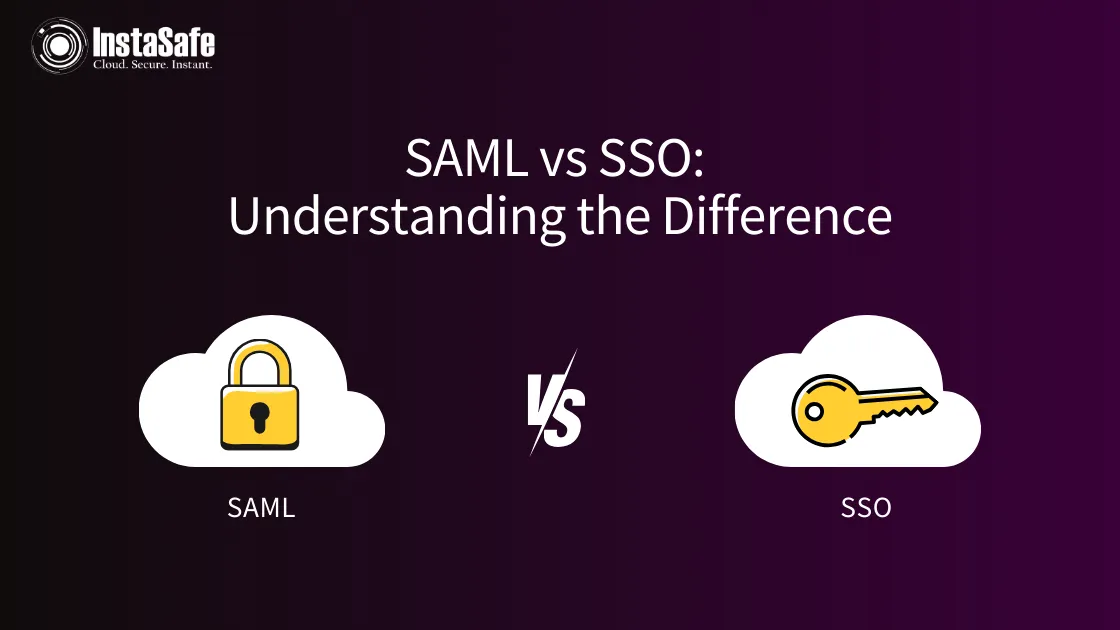SAML vs. SSO: Understanding The Differences

Modern ways of authenticating user identity are about the balance between protection, security, and convenience. It is very important to keep your users and their safety and convenience in mind while you create a certain type of technology to secure their online existence.
SSO and SAML are the kinds of solutions that find a median to it! Although these two essentially are authentication solutions, their forms are different. One is a protocol, SAML, while the other is a process, SSO. The difference between SAML and SSO lies in the basics.
Let us understand more about SSO and SAML authentication.
What Is SSO?
SSO, which stands for Single Sign-On, is a process of authentication that allows users to log into different accounts using a single pair of credentials.
The biggest example of this technology can be seen with your accounts connected to your Google account: Gmail, YouTube, Facebook, Google Suite and Instagram, among others.
What is SAML?
Security Assertion Markup Language (SAML) is a protocol or a standard that defines the rules and regulations of authentication for a certain application.
This protocol technology helps the client to verify whether the person/user is who they say they are and not someone else, working like an identification tool as well.
So, why do people confuse these two technologies? It is only basically due to the fact that they work towards the authentication of user identities. To understand more nuanced and primary differences between these two, SAML and SSO, you must first understand how they function.
SAML vs SSO: Different Functioning
How does SAML work?
- The Components
There are 3 primary components involved in the functioning of SAML: the user, the identity provider (IdP), and the service provider.
The user is the person in concern, the one who is being identified, trying to gain access to the network or web application.
The identity provider is software that stores the identity of the user and confirms it to the server. The IdP also stores information that allows the server to know the position of the user and what level of access is allowed to them.
The service provider is the web application or network the user is trying to access.
- The Process
The procedure begins when the user/subject of the procedure makes a request to access the network or web application, i.e., the service provider. The service provider checks in with the IdP and verifies the identity of the user seeking access. The request is assessed, and the service provider receives a response.
The identity provider sends a SAML assertion to the service provider, signifying that the user is already signed in. If the user is already logged in, the user gains access (if IdP responds positively).
If the user is not logged in, they will have to enter their credentials or whatever the authentication tool demands.
How does SSO login work?
- The Components
The 3 components necessary for SAML are used in SSO, too. Along with those, there is a concept that is an additional component in this procedure: authentication token.
The authentication token is a digital permission or virtual permission Identity proof provided to the user. This token is granted to the user based on the information stored in their browser or the service provider’s server.
- The Process
When the user makes a request to the web application or browser to gain access to the network, the request is assessed by all the internal tools, identity providers and service providers and then reflected in the SSO service’s data. If the stored information checks with the authentication token, the user is logged in without having to go through all the login steps.
However, if the user is not signed in, the user will be prompted by the SSO service to log into the account.
SAML vs SSO: Advantages and Disadvantages
Conclusion
If we observe keenly, the processes for both technologies are a little similar to the SAML protocol because most SSO services use SAML-based authentication tools to authenticate their users. Hence, the similarity, and hence, the differences!
Now, understanding the difference between SAML and SSO – their processes and procedures begins with understanding their advantages and disadvantages. Knowing these technologies is important for users as well as network owners.
Moreover, investing in Identity and Access Management (IDAM) solutions like MFA and SSO from trusted providers can do wonders to bolster the security of your technology stacks.
We at InstaSafe strive to offer the best of the best when it comes to security, so come check us out!
Frequently Asked Questions (FAQs)
What is the role of SAML in SSO authentication?
SAML enables safe and secure web domains to verify, assess, and exchange user authentication and authorisation information with the service provider that uses SSO authentication.
Who can use SSO?
Business organisations that have internal networks that operate different applications and websites and if their employees, on-site or remote, work on these applications, the business should opt for SSO authentication.
What type of protocol is SAML?
SAML is an Extensible Markup Language, XML-based authentication protocol. XML is a language that formats, stores, transmits and reconstructs arbitrary data.
Key Products
Multi Factor Authentication | Identity And Access Management | ZTNA | Zero Trust Application Access | Secure Enterprise Browser
Key Features
Single Sign On | Endpoint Security | Device Binding | Domain Joining | Always On VPN | Contextual Access | Clientless Remote Access | Device Posture Check
Key Solutions
VPN Alternatives | DevOps Security | Cloud Application Security | Secure Remote Access | VoIP Security
